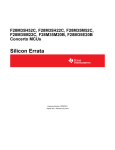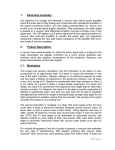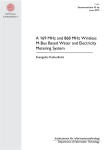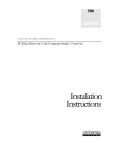Download MAP electronics Cocerto-B Specifications
Transcript
F28M35H20B1, F28M35H20C1, F28M35H22B1, F28M35H22C1, F28M35H32B1, F28M35H32C1, F28M35H50B1, F28M35H50C1, F28M35H52B1, F28M35H52C1 Concerto MCU Silicon Errata Literature Number: SPRZ357B August 2011 – Revised January 2012 2 SPRZ357B – August 2011 – Revised January 2012 Submit Documentation Feedback Copyright © 2011–2012, Texas Instruments Incorporated Contents 1 2 3 4 5 6 Introduction ........................................................................................................................ 5 Device and Development Support Tool Nomenclature ............................................................. 5 Device Markings ................................................................................................................. 6 Known Design Marginality/Exceptions to Functional Specifications .......................................... 7 Documentation Support ..................................................................................................... 18 Revision History ................................................................................................................ 19 SPRZ357B – August 2011 – Revised January 2012 Submit Documentation Feedback Copyright © 2011–2012, Texas Instruments Incorporated Table of Contents 3 www.ti.com List of Figures 1 Example of Device Markings .............................................................................................. 6 2 Example of Device Nomenclature ........................................................................................ 6 List of Tables 4 ................................................................... ................................................................................................................ 1 Determining Silicon Revision From Lot Trace Code 6 2 Advisory List 7 List of Figures SPRZ357B – August 2011 – Revised January 2012 Submit Documentation Feedback Copyright © 2011–2012, Texas Instruments Incorporated Silicon Errata SPRZ357B – August 2011 – Revised January 2012 F28M35x Concerto MCU Silicon Errata 1 Introduction This document describes the silicon updates to the functional specifications for the F28M35x microcontrollers (MCUs). The updates are applicable to: • 144-pin PowerPAD™ Thermally Enhanced Thin Quad Flatpack, RFP Suffix 2 Device and Development Support Tool Nomenclature To designate the stages in the product development cycle, TI assigns prefixes to the part numbers of all Concerto™ MCU devices and support tools. Each Concerto™ MCU commercial family member has one of three prefixes: x, p, or no prefix (e.g., xF28M35H52C1RFPT). Texas Instruments recommends two of three possible prefix designators for its support tools: TMDX and TMDS. These prefixes represent evolutionary stages of product development from engineering prototypes (with prefix x/TMDX) through fully qualified production devices/tools (no prefix/TMDS). xF28M35... pF28M35... F28M35... Experimental device that is not necessarily representative of the final device's electrical specifications Final silicon die that conforms to the device's electrical specifications but has not completed quality and reliability verification Fully qualified production device Support tool development evolutionary flow: TMDX Development-support product that has not yet completed Texas Instruments internal qualification testing TMDS Fully qualified development-support product Devices with prefix x or p and TMDX development-support tools are shipped against the following disclaimer: "Developmental product is intended for internal evaluation purposes." Production devices and TMDS development-support tools have been characterized fully, and the quality and reliability of the device have been demonstrated fully. TI's standard warranty applies. Predictions show that prototype devices with prefix of x or p have a greater failure rate than the standard production devices. Texas Instruments recommends that these devices not be used in any production system because their expected end-use failure rate still is undefined. Only qualified production devices are to be used. TI device nomenclature also includes a suffix with the device family name. This suffix indicates the package type (for example, RFP) and temperature range (for example, T). PowerPAD, Concerto, TMS320C28x, C28x, StellarisWare are trademarks of Texas Instruments. Cortex is a trademark of ARM Limited. ARM is a registered trademark of ARM Ltd or its subsidiaries. Philips is a registered trademark of Koninklijke Philips Electronics N.V. All other trademarks are the property of their respective owners. SPRZ357B – August 2011 – Revised January 2012 Submit Documentation Feedback F28M35x Concerto MCU Silicon Errata Copyright © 2011–2012, Texas Instruments Incorporated 5 Device Markings 3 www.ti.com Device Markings Figure 1 provides an example of the Concerto device markings and defines each of the markings. The device revision can be determined by the symbols marked on the top of the package as shown in Figure 1. Some prototype devices may have markings different from those illustrated. Figure 2 shows an example of the device nomenclature. YMLLLLS = Lot Trace Code x 980 YM LLLL S $$ 980 F28M35H52C1RFPT $$-YMLLLLS = = = = = 2-Digit Year/Month Code Assembly Lot Assembly Site Code Wafer Fab Code as applicable TI EIA Code G4 = Green (Low Halogen and RoHS-compliant) G4 Package Pin 1 Figure 1. Example of Device Markings Table 1. Determining Silicon Revision From Lot Trace Code SECOND LETTER IN PREFIX OF LOT TRACE CODE SILICON REVISION REVISION ID Indicates Revision 0 Cortex™-M3: 0x400F EC00 C28x™: 0x0883 Blank (no second letter in prefix) COMMENTS 0x0000 5 F28M3 x H 5 2 C 1 RFP This silicon revision is available as x (experimental device). T PREFIX TEMPERATURE RANGE T = −40°C to 105°C S = −40°C to 125°C Q = −40°C to 125°C (Q refers to Q100 qualification for automotive applications.) = experimental device x = prototype device p no prefix = qualified device DEVICE FAMILY F28M3 = Concerto TM PACKAGE TYPE TM 144-Pin RFP PowerPAD Thermally Enhanced Thin Quad Flatpack (HTQFP) SERIES NUMBER PINS 1 = 144 pins PERFORMANCE (C28x TM TM Speed / Cortex -M3 Speed) H = 150 / 75 MHz or 100 / 100 MHz M = 75 / 75 MHz E = 60 / 60 MHz PERIPHERALS C = Connectivity B = Base FLASH 2 = 256KB each core 3 = additional 256KB to one core 5 = 512KB each core A (A) RAM 0 = 72KB 2 = additional 64KB of masterable RAM The additional 256KB is added to the Cortex™-M3 core (Connectivity Devices) or to the C28x™ core (Base Devices). Figure 2. Example of Device Nomenclature 6 F28M35x Concerto MCU Silicon Errata SPRZ357B – August 2011 – Revised January 2012 Submit Documentation Feedback Copyright © 2011–2012, Texas Instruments Incorporated Known Design Marginality/Exceptions to Functional Specifications www.ti.com 4 Known Design Marginality/Exceptions to Functional Specifications Table 2. Advisory List Title ...................................................................................................................................... Page Advisory — Debug: Global Run of Cortex™-M3 and TMS320C28x™ is not Operational ..................................... Advisory — Debug: Cross-Trigger Functionality is Limited When Using Breakpoints on the C28x Core .................... Advisory — Debug: Control Subsystem Boot ROM M0 RAM-INIT Does Not Wait for RAM-INIT to Complete ............. Advisory — NMI: Writing a "0" to Any of the CNMIFRC/MNMIFRC Register Bits Clears the Corresponding Flag Bit in CNMIFLG/MNMIFLG ........................................................................................................... Advisory — PLL: Setting SYSPLLMULT or UPLLMULT to 0x0000 causes "/0" Condition in PLL Logic .................... Advisory — USB: VBUS Pin May Clamp to 3.3-V Supply, Preventing Proper OTG Mode Operation ....................... Advisory — USB: Host Mode — Cannot Communicate With Low-Speed Device Through a Hub ........................... Advisory — Control Subsystem: Reset Value (/8) of CCLKCTL.CLKDIV Bit Field Violates the MIN Requirement Mandated by the Data Manual for ACIBCLK, When the Input Clock to the Divider is Less Than 40 MHz ....... Advisory — Master Subsystem: MNMIFLG.NMIINT Bit Will Not be Set in Some Cases When an NMI is Still Pending ......................................................................................................................... Advisory — Master Subsystem I2C: Data Hold Time Violates Philips® I2C Specification .................................... Advisory — Master Subsystem MPU: Memory Protection Unit is Disabled .................................................... Advisory — Master Subsystem Boot ROM: NMI Handler Can Return Before Clearing All the Pending NMIs, if There is a Nested NMI ............................................................................................................... Advisory — Master Boot ROM: NMI Handler Not Executed if NMI Occurs at Power Up or Immediately After a Reset . Advisory — Master Boot ROM: Parallel Boot Mode Will Not Work as Intended ............................................... Advisory — GPIO: GPIOs on Port C Do Not Toggle Correctly When Using the GPCTOGGLE Register .................. Advisory — C28x Flash: Code Executing From the C28x Subsystem Flash May be Subject to Unnecessary 1-Cycle Delays .......................................................................................................................... Advisory — C28x Clocking: EALLOW Protection of C28x Clocking Registers Prevents Read of Registers............... Advisory — µDMA: No Transfer Completion Interrupt From SW Channels, Other Than Channel 30 ...................... Advisory — Read of Clock Control Registers on C28x Memory Map is EALLOW-Protected ................................ Advisory — VCU: First CRC Calculation May Not be Correct.................................................................... Advisory — UART: RTRIS Bit in the UARTRIS Register is Only Set When the Interrupt is Enabled ....................... Advisory — Flash ECC: When Program/Data Cache is Enabled, ECC Errors are Captured Only on a Single 64-Bit Slice and Not on the Full 128-Bit Flash Bank Data Width .............................................................. Advisory — Flash ECC: C28x 'Flash Uncorrectable' Error Generated When Executing F021 Flash API Functions With Flash ECC Enabled..................................................................................................... Advisory — VREG: VREG 'Warn Lo/High' Feature Does Not Work as Intended .............................................. Advisory — Temperature Sensor: getTempSlope() and getTempOffset() Functions are not Available on TMX Silicon . Advisory — EMAC: Resetting EMAC Controller Using SRCR2 Register Does Not Automatically Reset the Ethernet PHY Via MII_PHYRST Signal ............................................................................................... Advisory — System Control: Clock Configuration Should Not be Changed When There are Pending/On-going Accesses to Shared RAM (Cx and Sx) or to Analog Subsystem ....................................................... Advisory — RAM Controller: Cortex™-M3 Accesses to Shared RAM (Cx and Sx) and to MSG RAM Do Not Work When Any Other Master (µDMA/C28x/DMA) Simultaneously Accesses the Same Memory ....................... Advisory — RAM Controller: µDMA Accesses to Shared RAM (Cx and Sx) and to MSG RAM Do Not Work When Any Other Master (Cortex™-M3/C28x/DMA) Simultaneously Accesses the Same Memory ....................... 8 8 8 9 9 9 9 10 11 11 11 12 12 12 13 13 13 13 14 14 14 15 15 16 16 16 16 17 17 NOTE: For errata relating to the Cortex™-M3 r2p0 core, see the ARM Core Cortex-M3 / Cortex-M3 with ETM (AT420/AT425) Errata Notice at the ARM® Ltd. website. SPRZ357B – August 2011 – Revised January 2012 Submit Documentation Feedback F28M35x Concerto MCU Silicon Errata Copyright © 2011–2012, Texas Instruments Incorporated 7 Known Design Marginality/Exceptions to Functional Specifications www.ti.com Advisory Debug: Global Run of Cortex™-M3 and TMS320C28x™ is not Operational Revision(s) Affected 0 Details Due to missing signals in the debug logic, global run of the Cortex™-M3 and C28x™ cores is not enabled. Workaround(s) None. This will be fixed in the next revision of the silicon. Advisory Debug: Cross-Trigger Functionality is Limited When Using Breakpoints on the C28x Core Revision(s) Affected 0 Details When cross-triggering is enabled, halting at a breakpoint set for the C28x core does not also halt the Cortex™-M3 core. Workaround(s) None Advisory Debug: Control Subsystem Boot ROM M0 RAM-INIT Does Not Wait for RAM-INIT to Complete Revision(s) Affected 0 Details C-Boot-ROM sets the RAM-INIT bit to zero-initialize the entire M0 RAM every time it is run after reset. However, it does not wait for the RAM-INIT to complete before accessing M0 RAM for run-time stack. This does not cause any problem on stand-alone device operation because this wait before RAM is accessed is inherently achieved by the wait to access Flash. As Flash power-up time is more than the M0 RAM-INIT time and the Boot ROM waits for Flash to power up completely before accessing RAM, by the time C-Boot-ROM accesses M0 RAM for stack, it is initialized properly. Workaround(s) On stand-alone device operation, this is not a problem because every time the device is reset, Flash has to be brought back to active state and this wait for Flash to come to active state is more than the time required for M0 RAM-INIT to complete. During debug/development, when the emulator is connected and the user wants to RUN through Boot ROM, care must be taken to ensure that Flash is not accessed before running through boot initialization or the user should carefully step through Boot ROM code at least until RAM-INIT is done, before clicking the RUN button on CCS. This will be fixed in the next revision of the silicon. 8 F28M35x Concerto MCU Silicon Errata SPRZ357B – August 2011 – Revised January 2012 Submit Documentation Feedback Copyright © 2011–2012, Texas Instruments Incorporated Known Design Marginality/Exceptions to Functional Specifications www.ti.com Advisory NMI: Writing a " 0" to Any of the CNMIFRC/MNMIFRC Register Bits Clears the Corresponding Flag Bit in CNMIFLG/MNMIFLG Revision(s) Affected 0 Details Writing a "0" to any of the bits in the Control Subsystem CNMIFRC register clears the corresponding bits in the CNMIFLG register. Likewise, writing a "0" to any of the bits in the Master Subsystem MNMIFRC register clears the corresponding bits in the MNMIFLG register. Workaround(s) Do not write "0" to any of the bits in the CNMIFRC register or MNMIFRC register. To clear the CNMIFLG and MNMIFLG bits, write a "1" to the corresponding bits in the respective CNMIFLGCLR and MNMIFLGCLR registers. This will be fixed in the next revision of the silicon. Advisory PLL: Setting SYSPLLMULT or UPLLMULT to 0x0000 causes " /0" Condition in PLL Logic Revision(s) Affected 0 Details Setting the SYSPLLMULT register or UPLLMULT register to 0x0000 to bypass the PLL causes a "/0" condition in the PLL logic and results in an unstable PLL output clock. Workaround(s) Do not write 0x0000 to the SYSPLLMULT register or UPLLMULT register to bypass either PLLs. Instead, to bypass the system PLL, set SYSPLLCTL[SPLLCLKEN] = 0. To bypass the USB PLL, set UPLLCTL[UPLLCLKEN] = 0. This will be fixed in the next revision of the silicon. Advisory USB: VBUS Pin May Clamp to 3.3-V Supply, Preventing Proper OTG Mode Operation Revision(s) Affected 0 Details The VBUS pin may clamp to VDDIO, preventing the pulldown resistors from taking effect in USB-OTG mode when attempting to end a session. Workaround(s) None Advisory USB: Host Mode — Cannot Communicate With Low-Speed Device Through a Hub Revision(s) Affected 0 Details When the USB controller is operating as a Host and a low-speed packet is sent to a device through a hub, the subsequent Start-of-Frame is corrupted. After a period of time, this corruption causes the USB controller to lose synchronization with the hub, which results in data corruption. Workaround(s) None SPRZ357B – August 2011 – Revised January 2012 Submit Documentation Feedback F28M35x Concerto MCU Silicon Errata Copyright © 2011–2012, Texas Instruments Incorporated 9 Known Design Marginality/Exceptions to Functional Specifications www.ti.com Advisory Control Subsystem: Reset Value (/8) of CCLKCTL.CLKDIV Bit Field Violates the MIN Requirement Mandated by the Data Manual for ACIBCLK, When the Input Clock to the Divider is Less Than 40 MHz Revision(s) Affected 0 Details On power up or after an external reset (XRS), PLL is bypassed and the Master Boot ROM configures the default SYSCLK divider to "/1". This makes the input clock to the divider the same as OSCCLK. If OSCCLK is less than 40 MHz, then upon power up or an external reset, ACIBCLK would be less than 5 MHz. However, this is not an issue because the Analog Subsystem needs not be functional during boot time. Workaround(s) An OTP function is provided in the Control Subsystem for users to call during their application initialization process and before using Analog Subsystem peripherals on the device. This function will configure the CCLKCTL divider as needed by the application. This will be fixed in the next revision of the silicon. 10 F28M35x Concerto MCU Silicon Errata SPRZ357B – August 2011 – Revised January 2012 Submit Documentation Feedback Copyright © 2011–2012, Texas Instruments Incorporated Known Design Marginality/Exceptions to Functional Specifications www.ti.com Advisory Master Subsystem: MNMIFLG.NMIINT Bit Will Not be Set in Some Cases When an NMI is Still Pending Revision(s) Affected 0 Details On the Master Subsystem, if there is a nested NMI and if the user clears the MNMIFLG.NMIINT bit before clearing all the other pending flags while returning from the first NMI handler, then the MNMIFLG.NMIINT bit will not be set while the second NMI is still pending. This pending NMI will keep the MNMIWD counter running and will reset the device if the pending flag is not cleared on time. If the second NMI among the nested NMI is a Missing-clock NMI, then immediately after MNMIWD reset, there will be another NMI because of the MCLKSTS bit being set. Workaround(s) User NMI handler should not depend on the MNMIFLG.NMIINT bit to determine if there is an active NMI pending and should instead look at all the individual bits to check if an NMI is pending. This will be fixed in the next revision of the silicon. Advisory Master Subsystem I2C: Data Hold Time Violates Philips® I2C Specification Revision(s) Affected 0 Details The Master subsystem I2C module’s data hold time on F28M35x Concerto devices is a minimum of 2 system clock cycles, which violates the Philips® I2C specification requirement of a minimum of 0 system clock cycle. Workaround(s) None Advisory Master Subsystem MPU: Memory Protection Unit is Disabled Revision(s) Affected 0 Details The Cortex™-M3 Memory Protection Unit (MPU) is disabled on the F28M35x Revision 0 silicon. Workaround(s) None. This will be fixed on the next revision of the silicon. SPRZ357B – August 2011 – Revised January 2012 Submit Documentation Feedback F28M35x Concerto MCU Silicon Errata Copyright © 2011–2012, Texas Instruments Incorporated 11 Known Design Marginality/Exceptions to Functional Specifications www.ti.com Advisory Master Subsystem Boot ROM: NMI Handler Can Return Before Clearing All the Pending NMIs, if There is a Nested NMI Revision(s) Affected 0 Details The Master Subsystem Boot ROM depends on the MNMIFLG.NMIINT bit to determine if there is a pending NMI on the Master Subsystem. However, as mentioned in the advisory titled "Master Subsystem: MNMIFLG.NMIINT Bit Will Not be Set in Some Cases When an NMI is Still Pending", this bit might not be set. Therefore, the Master Boot ROM NMI handler might return while there is an active NMI pending and MNMIWD counter running. This will trigger MNMIWDRST and reset the entire device. The probability of nested NMI happening during boot time is highly unlikely, unless there is a critical issue elsewhere in the device. Workaround(s) None. This will be fixed in the next revision of the silicon. Advisory Master Boot ROM: NMI Handler Not Executed if NMI Occurs at Power Up or Immediately After a Reset Revision(s) Affected 0 Details If there is an NMI at power up or immediately after a reset, the master Boot ROM will branch to the NMI handler. Since access to all memories is blocked upon reset, the NMI handler will not be able to acknowledge the NMI, which will cause the MNMIWD counter to eventually overflow and reset the device. If this NMI is a missing clock NMI, there will be another NMI after the MNMIWD reset because the MCLKSTS bit is not cleared by an external (or watchdog) reset. Therefore, if there is a missing clock condition upon power up or immediately after an external reset, then the device will keep resetting over and over again. Workaround(s) None. This will be fixed in the next revision of the silicon. Advisory Master Boot ROM: Parallel Boot Mode Will Not Work as Intended Revision(s) Affected 0 Details Parallel boot mode does not transfer data into the device in the intended format. Workaround(s) Use ARM® production programming solutions for Cortex™-M3 programming. This will be fixed in the Boot ROM in the next revision of the silicon. 12 F28M35x Concerto MCU Silicon Errata SPRZ357B – August 2011 – Revised January 2012 Submit Documentation Feedback Copyright © 2011–2012, Texas Instruments Incorporated Known Design Marginality/Exceptions to Functional Specifications www.ti.com Advisory GPIO: GPIOs on Port C Do Not Toggle Correctly When Using the GPCTOGGLE Register Revision(s) Affected 0 Details GPIOs on Port C do not toggle correctly when using the GPCTOGGLE register because of a dependency on the state of GPIOs on Port A. Workaround(s) Use GPCSET and GPCCLEAR registers or the GPCDAT register to toggle Port C GPIOs. This will be fixed in the next revision of the silicon. Advisory C28x Flash: Code Executing From the C28x Subsystem Flash May be Subject to Unnecessary 1-Cycle Delays Revision(s) Affected 0 Details Code executing from the C28x Subsystem Flash may be subject to unnecessary 1-cycle delays. This delay will not occur more often than once every 8 instructions for code that is composed of linear 32-bit opcodes with no pipeline delays (worst case). In practice, the unnecessary delay occurs rarely since the C28x uses both 16-bit opcodes and 32-bit opcodes. This delay can occur when Flash wait states are set to "3" and the prefetch mechanism is enabled. This delay does not occur when the wait states are set to "2" or "1" with prefetch enabled. Workaround(s) None. This will be fixed in the next revision of the silicon. Advisory C28x Clocking: EALLOW Protection of C28x Clocking Registers Prevents Read of Registers Revision(s) Affected 0 Details The EALLOW protection of the C28x clocking registers prevents reads to these registers (reads return 0x0000) in addition to preventing writes to the registers (expected behavior of EALLOW-protection) when EALLOW is not set. Workaround(s) Prior to reading C28x clocking registers, the application code must first execute the “EALLOW” command. This will be fixed in the next revision of the silicon. Advisory µDMA: No Transfer Completion Interrupt From SW Channels, Other Than Channel 30 Revision(s) Affected 0 Details On a Concerto device, if any SW channel, other than Channel 30, is used for data transfer, then there will be no completion interrupt generated on the µDMA interrupt line when data transfer is done. Workaround(s) The user must poll for the STATE field of the DMASTAT register of SW channel, used for data transfer, to get set to “0x9” to detect completion of data transfer. SPRZ357B – August 2011 – Revised January 2012 Submit Documentation Feedback F28M35x Concerto MCU Silicon Errata Copyright © 2011–2012, Texas Instruments Incorporated 13 Known Design Marginality/Exceptions to Functional Specifications www.ti.com Advisory Read of Clock Control Registers on C28x Memory Map is EALLOW-Protected Revision(s) Affected 0 Details Clock Control Registers on the C28x memory map are read-protected by EALLOW. Workaround(s) Enable EALLOW before reading the Clock Control Registers on the C28x memory map. Advisory VCU: First CRC Calculation May Not be Correct Revision(s) Affected 0 Details Due to the internal power-up state of the VCU module, it is possible that the first CRC result will be incorrect. This applies to the first result from each of the eight CRC instructions. This condition can only occur after a power-on reset, but will not necessarily occur on every power on. A warm reset will not cause this condition to reappear. Workaround(s) The application can reset the internal VCU CRC logic by performing a CRC calculation of a single byte in the initialization routine. This routine only needs to perform one CRC calculation and can use any of the CRC instructions. At the end of this routine, clear the VCU CRC result register to discard the result. An example is shown below. _VCUcrc_reset MOVZ XAR7, #0 VCRC8L_1 *XAR7 VCRCCLR LRETR This will be fixed in the next revision of the silicon. Advisory UART: RTRIS Bit in the UARTRIS Register is Only Set When the Interrupt is Enabled Revision(s) Affected 0 Details The RTRIS (UART Receive Time-Out Raw Interrupt Status) bit in the UART Raw Interrupt Status (UARTRIS) register should be set when a receive time-out occurs, regardless of the state of the RTIM enable bit in the UART Interrupt Mask (UARTIM) register. However, currently the RTIM bit must be set in order for the RTRIS bit to be set when a receive time-out occurs. Workaround(s) For applications that require polled operation, the RTIM bit can be set while the UART interrupt is disabled in the NVIC using the IntDisable(n) function in the StellarisWare™ Peripheral Driver Library, where n is 21, 22, or 49, depending on whether UART0, UART1, or UART2 is used. With this configuration, software can poll the RTRIS bit, but the interrupt is not reported to the NVIC. 14 F28M35x Concerto MCU Silicon Errata SPRZ357B – August 2011 – Revised January 2012 Submit Documentation Feedback Copyright © 2011–2012, Texas Instruments Incorporated Known Design Marginality/Exceptions to Functional Specifications www.ti.com Advisory Flash ECC: When Program/Data Cache is Enabled, ECC Errors are Captured Only on a Single 64-Bit Slice and Not on the Full 128-Bit Flash Bank Data Width Revision(s) Affected 0 Details When the prefetch/cache is enabled using the RD_INTF_CTRL register, ECC is verified only on the 64-bit slice that is requested by the CPU; the other 64-bit slice of the 128-bit Flash bank data width is not verified for ECC errors, and instead, is just loaded into the cache. This is applicable for both Cortex™-M3 and C28x Flash memory modules. Workaround(s) None Advisory Flash ECC: C28x 'Flash Uncorrectable' Error Generated When Executing F021 Flash API Functions With Flash ECC Enabled Revision(s) Affected 0 Details On the Control Subsystem, when Flash ECC is enabled (C28 ECC_ENABLE[ENABLE] = 0xA), execution of any F021 Flash API functions will generate a "Flash Uncorrectable" error and an NMI. Flash ECC is enabled by default. Workaround(s) Disable C28x Flash ECC before calling F021 Flash API functions by setting C28 ECC_ENABLE[ENABLE] equal to any value other than 0xA. Then, re-enable C28x Flash ECC by setting C28 ECC_ENABLE[ENABLE] equal to 0xA, if desired, after F021 Flash API functions have finished executing. This will be fixed in the next revision of the silicon. SPRZ357B – August 2011 – Revised January 2012 Submit Documentation Feedback F28M35x Concerto MCU Silicon Errata Copyright © 2011–2012, Texas Instruments Incorporated 15 Known Design Marginality/Exceptions to Functional Specifications www.ti.com Advisory VREG: VREG 'Warn Lo/High' Feature Does Not Work as Intended Revision(s) Affected 0 Details The VREG "Warn Lo/High" feature should not be used or enabled in the F28M35x Revision 0 devices. Do not set the VREGWARNE bit in the MNMICFG register as it could negatively affect the VREG output voltage. Workaround(s) None. This will be fixed in the next revision of the silicon. Advisory Temperature Sensor: getTempSlope() and getTempOffset() Functions are not Available on TMX Silicon Revision(s) Affected 0 Details The getTempSlope() and getTempOffset() functions are not available for use on TMX silicon. Workaround(s) None Advisory EMAC: Resetting EMAC Controller Using SRCR2 Register Does Not Automatically Reset the Ethernet PHY Via MII_PHYRST Signal Revision(s) Affected 0 Details Resetting the EMAC controller by setting Bit 28 of the SRCR2 register does not automatically reset the Ethernet PHY that is connected to the controller via the MII_PHYRST function on the IO pin. Workaround(s) The microcontroller signal or pin connected to the Reset pin on the Ethernet PHY should be configured as a GPIO instead of as an MII_PHYRST peripheral pin; and the GPIO must be toggled before resetting the EMAC controller. Toggling the GPIO pin (HIGH → LOW → HIGH) will reset the PHY, assuming the reset for your PHY is an active-low signal. Advisory System Control: Clock Configuration Should Not be Changed When There are Pending/On-going Accesses to Shared RAM (Cx and Sx) or to Analog Subsystem Revision(s) Affected 0 Details If the clock configuration is being changed (e.g., changing the clock divider for Cortex™-M3) when there is a pending/on-going access to Shared RAM (Cx/Sx) or to the Analog Subsystem, the access could generate an error. Workaround(s) Software should ensure that there is no pending/on-going access to Shared RAM or to the Analog Subsystem when the clock configuration is being changed. 16 F28M35x Concerto MCU Silicon Errata SPRZ357B – August 2011 – Revised January 2012 Submit Documentation Feedback Copyright © 2011–2012, Texas Instruments Incorporated Known Design Marginality/Exceptions to Functional Specifications www.ti.com Advisory RAM Controller: Cortex™-M3 Accesses to Shared RAM (Cx and Sx) and to MSG RAM Do Not Work When Any Other Master (µDMA/C28x/DMA) Simultaneously Accesses the Same Memory Revision(s) Affected 0 Details If Cortex™-M3 accesses Shared RAM (Cx and Sx) or MSG RAM when any other master (µDMA/C28x/DMA) accesses the same memory, data and parity may get corrupted in the memory. Workaround(s) When Cortex™-M3 accesses Shared RAM or MSG RAM, no other master (µDMA/C28x/DMA) should access the same memory at that time. Advisory RAM Controller: µDMA Accesses to Shared RAM (Cx and Sx) and to MSG RAM Do Not Work When Any Other Master (Cortex™-M3/C28x/DMA) Simultaneously Accesses the Same Memory Revision(s) Affected 0 Details If µDMA accesses Shared RAM (Cx and Sx) or MSG RAM when any other master (Cortex™-M3/C28x/DMA) accesses the same memory, data and parity may get corrupted in the memory. Workaround(s) When µDMA accesses Shared RAM or MSG RAM, no other master (Cortex™-M3/C28x/DMA) should access the same memory at that time. SPRZ357B – August 2011 – Revised January 2012 Submit Documentation Feedback F28M35x Concerto MCU Silicon Errata Copyright © 2011–2012, Texas Instruments Incorporated 17 Documentation Support 5 www.ti.com Documentation Support For device-specific data sheets and related documentation, visit the TI web site at: http://www.ti.com. For further information regarding the F28M35x Concerto devices, see the F28M35H20B1, F28M35H20C1, F28M35H22B1, F28M35H22C1, F28M35H32B1, F28M35H32C1,F28M35H50B1, F28M35H50C1, F28M35H52B1, F28M35H52C1 Concerto Microcontrollers Data Manual (literature number SPRS742). For errata relating to the Cortex™-M3 r2p0 core, see the ARM Core Cortex-M3 / Cortex-M3 with ETM (AT420/AT425) Errata Notice at the ARM® Ltd. website. 18 F28M35x Concerto MCU Silicon Errata SPRZ357B – August 2011 – Revised January 2012 Submit Documentation Feedback Copyright © 2011–2012, Texas Instruments Incorporated Revision History www.ti.com 6 Revision History This revision history highlights the technical changes made to the SPRZ357A errata document to make it an SPRZ357B revision. Scope: See table below. LOCATION ADDITIONS, DELETIONS, AND MODIFICATIONS Figure 2 Updated "Example of Device Nomenclature" figure Section 4 Known Design Marginality/Exceptions to Functional Specifications: • Added "USB: Host Mode — Cannot Communicate With Low-Speed Device Through a Hub" advisory • Added "Master Subsystem MPU: Memory Protection Unit is Disabled" advisory • Added "Flash ECC: When Program/Data Cache is Enabled, ECC Errors are Captured Only on a Single 64-Bit Slice and Not on the Full 128-Bit Flash Bank Data Width" advisory • Added "Flash ECC: C28x 'Flash Uncorrectable' Error Generated When Executing F021 Flash API Functions With Flash ECC Enabled" advisory • Added "VREG: VREG 'Warn Lo/High' Feature Does Not Work as Intended" advisory • Added "Temperature Sensor: getTempSlope() and getTempOffset() Functions are not Available on TMX Silicon" advisory • Added "EMAC: Resetting EMAC Controller Using SRCR2 Register Does Not Automatically Reset the Ethernet PHY Via MII_PHYRST Signal" advisory • Added "System Control: Clock Configuration Should Not be Changed When There are Pending/On-going Accesses to Shared RAM (Cx and Sx) or to Analog Subsystem" advisory • Added "RAM Controller: Cortex™-M3 Accesses to Shared RAM (Cx and Sx) and to MSG RAM Do Not Work When Any Other Master (µDMA/C28x/DMA) Simultaneously Accesses the Same Memory" advisory • Added "RAM Controller: µDMA Accesses to Shared RAM (Cx and Sx) and to MSG RAM Do Not Work When Any Other Master (Cortex™-M3/C28x/DMA) Simultaneously Accesses the Same Memory" advisory SPRZ357B – August 2011 – Revised January 2012 Submit Documentation Feedback F28M35x Concerto MCU Silicon Errata Copyright © 2011–2012, Texas Instruments Incorporated 19 IMPORTANT NOTICE Texas Instruments Incorporated and its subsidiaries (TI) reserve the right to make corrections, modifications, enhancements, improvements, and other changes to its products and services at any time and to discontinue any product or service without notice. Customers should obtain the latest relevant information before placing orders and should verify that such information is current and complete. All products are sold subject to TI’s terms and conditions of sale supplied at the time of order acknowledgment. TI warrants performance of its hardware products to the specifications applicable at the time of sale in accordance with TI’s standard warranty. Testing and other quality control techniques are used to the extent TI deems necessary to support this warranty. Except where mandated by government requirements, testing of all parameters of each product is not necessarily performed. TI assumes no liability for applications assistance or customer product design. Customers are responsible for their products and applications using TI components. To minimize the risks associated with customer products and applications, customers should provide adequate design and operating safeguards. TI does not warrant or represent that any license, either express or implied, is granted under any TI patent right, copyright, mask work right, or other TI intellectual property right relating to any combination, machine, or process in which TI products or services are used. Information published by TI regarding third-party products or services does not constitute a license from TI to use such products or services or a warranty or endorsement thereof. Use of such information may require a license from a third party under the patents or other intellectual property of the third party, or a license from TI under the patents or other intellectual property of TI. Reproduction of TI information in TI data books or data sheets is permissible only if reproduction is without alteration and is accompanied by all associated warranties, conditions, limitations, and notices. Reproduction of this information with alteration is an unfair and deceptive business practice. TI is not responsible or liable for such altered documentation. Information of third parties may be subject to additional restrictions. Resale of TI products or services with statements different from or beyond the parameters stated by TI for that product or service voids all express and any implied warranties for the associated TI product or service and is an unfair and deceptive business practice. TI is not responsible or liable for any such statements. TI products are not authorized for use in safety-critical applications (such as life support) where a failure of the TI product would reasonably be expected to cause severe personal injury or death, unless officers of the parties have executed an agreement specifically governing such use. Buyers represent that they have all necessary expertise in the safety and regulatory ramifications of their applications, and acknowledge and agree that they are solely responsible for all legal, regulatory and safety-related requirements concerning their products and any use of TI products in such safety-critical applications, notwithstanding any applications-related information or support that may be provided by TI. Further, Buyers must fully indemnify TI and its representatives against any damages arising out of the use of TI products in such safety-critical applications. TI products are neither designed nor intended for use in military/aerospace applications or environments unless the TI products are specifically designated by TI as military-grade or "enhanced plastic." Only products designated by TI as military-grade meet military specifications. Buyers acknowledge and agree that any such use of TI products which TI has not designated as military-grade is solely at the Buyer's risk, and that they are solely responsible for compliance with all legal and regulatory requirements in connection with such use. TI products are neither designed nor intended for use in automotive applications or environments unless the specific TI products are designated by TI as compliant with ISO/TS 16949 requirements. Buyers acknowledge and agree that, if they use any non-designated products in automotive applications, TI will not be responsible for any failure to meet such requirements. Following are URLs where you can obtain information on other Texas Instruments products and application solutions: Products Applications Audio www.ti.com/audio Automotive and Transportation www.ti.com/automotive Amplifiers amplifier.ti.com Communications and Telecom www.ti.com/communications Data Converters dataconverter.ti.com Computers and Peripherals www.ti.com/computers DLP® Products www.dlp.com Consumer Electronics www.ti.com/consumer-apps DSP dsp.ti.com Energy and Lighting www.ti.com/energy Clocks and Timers www.ti.com/clocks Industrial www.ti.com/industrial Interface interface.ti.com Medical www.ti.com/medical Logic logic.ti.com Security www.ti.com/security Power Mgmt power.ti.com Space, Avionics and Defense www.ti.com/space-avionics-defense Microcontrollers microcontroller.ti.com Video and Imaging www.ti.com/video RFID www.ti-rfid.com OMAP Mobile Processors www.ti.com/omap Wireless Connectivity www.ti.com/wirelessconnectivity TI E2E Community Home Page e2e.ti.com Mailing Address: Texas Instruments, Post Office Box 655303, Dallas, Texas 75265 Copyright © 2012, Texas Instruments Incorporated



























